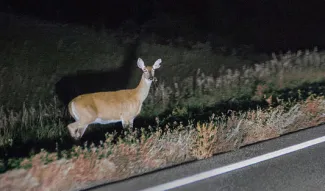
Fewer daylight hours and cooler weather signal white-tailed deer to enter breeding season, commonly called “the rut.” Over several weeks from late October into December, deer movement increases as bucks are chasing does with just one thing on their minds.
In November, it becomes particularly important to pay attention, said Dallas Barber, big game biologist for the Oklahoma Department of Wildlife Conservation.
In 2016, there were 424 reported vehicle accidents involving deer in Oklahoma, according to AAA Oklahoma. The Quality Deer Management Association said an estimated 1 million deer-vehicle collisions occur annually across the United States, causing about 200 human fatalities and nearly $2 billion in property damage.
“As the rut starts to pick up, they put caution to the wind, and we’ll see an increase in collisions,” Barber said. “A lot of the time with a vehicle, you’re either hitting a doe being pushed by a buck, or a buck that is chasing a doe that already crossed the road.”
With many deer moving about, motorists are more likely to encounter them on or near roadways. In fact, scientific studies have confirmed that the breeding season, increased deer movement and the number of deer-vehicle collisions show a strong correlation.
QDMA shared these tips for motorists who encounter deer on the highway:
- If a collision is imminent, do not swerve to avoid the deer. It is safer to continue straight ahead and brake than to end up in the oncoming lane or on the shoulder, where the situation could become much more hazardous.
- Anticipate the possibility of deer on the highway, especially around dawn and dusk when movement tends to increase. However, during the rut, deer may be moving anytime of the day or night.
- Put headlights on the bright setting to see better when there is no oncoming traffic. Also, turning down the brightness of the dashboard lighting will help drivers with night vision, making their headlights seem brighter.
- If you spot a deer ahead of you, slow down early, honk your horn and flash your headlights to frighten them away. If other traffic is nearby, turn on your emergency flashers and tap your brakes to alert other drivers to potential danger ahead.
- Know that deer can become confused or dazed by your headlights, and they could suddenly dart out in front of you.
- Be aware of “Deer Crossing” signs, as these are placed in areas with a history of increased deer movement across roadways.
- Don’t rely on “deer whistles.” Studies have shown that deer react no differently to vehicles with the devices as they do to vehicles that do not have them. Deer can pinpoint sound sources, so honking the horn is a better option to try to scare them off the road.
- Watch for the next in line. When you see a doe cross the road, at least one buck and maybe more will likely be following. Slow your vehicle and be prepared to stop.
When a deer is killed on the roadway, the driver or anyone else can salvage the animal for its meat, provided they have the proper permissions. But be mindful that deer are a regulated game animal, and anyone harvesting a deer outside of the normal hunting regulations must first obtain approval from law enforcement.
Someone who removes any portion of the meat or the head or antlers without permission could be charged with illegal possession of wildlife parts.
Call a local game warden or other law enforcement officer to ask about salvaging the animal. Also, many game wardens maintain lists of needy families who could use the meat.